
Phycology is the scientific study of algae. Also known as algology, phycology is a branch of life science.
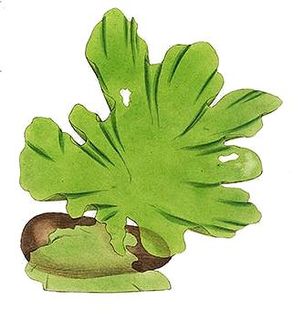
The sea lettuces comprise the genus Ulva, a group of edible green algae that is widely distributed along the coasts of the world's oceans. The type species within the genus Ulva is Ulva lactuca, lactuca being Latin for "lettuce". The genus also includes the species previously classified under the genus Enteromorpha, the former members of which are known under the common name green nori.

Oscillatoria is a genus of filamentous cyanobacterium which is named after the oscillation in its movement. Filaments in the colonies can slide back and forth against each other until the whole mass is reoriented to its light source. It is commonly found in watering-troughs waters, and is mainly blue-green or brown-green. Oscillatoria is an organism that reproduces by fragmentation. Oscillatoria forms long filaments of cells which can break into fragments called hormogonia. The hormogonia can grow into a new, longer filament. Breaks in the filament usually occur where dead cells (necridia) are present. It occur in fresh water ponds. Oscillatoria uses photosynthesis to survive and reproduce. Each filament of oscillatoria consists of trichome which is made up of rows of cells. The tip of the trichome oscillates like a pendulum. in reproduction, it takes place by vegetative means only. Usually the filament breaks into a number of fragments called hormogonia. Each hormogonium consist of one or more cells and grow into a filament by cell division in one direction.

Porphyra is a coldwater seaweed that grows in cold, shallow seawater. More specifically, it belongs to red algae phylum of laver species, comprising approximately 70 species. It grows in the intertidal zone, typically between the upper intertidal zone and the splash zone in cold waters of temperate oceans. In East Asia, it is used to produce the sea vegetable products nori and gim. There are considered to be 60 to 70 species of Porphyra worldwide and seven around Britain and Ireland where it has been traditionally used to produce edible sea vegetables on the Irish Sea coast. Porphyra is a chief source of plant-based vitamin B12.
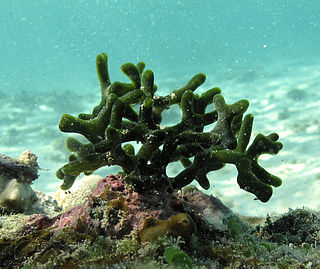
Codium is a genus of seaweed in the Chlorophyta of the order Bryopsidales. Paul Silva was an expert on the genus Codium taxonomy at the University of California at Berkeley. There are about 50 species worldwide.

Chordariaceae is a family of brown algae. Members of this family are may be filamentous, crustose with fused cells at the base, or they may be terete and differentiated into a central medulla and an outer photosynthetic cortex. They have a sporphytic thallus usually aggregated to form a pseudo-parenchyma.

Max Carl Wilhelm Weber van Bosse or Max Wilhelm Carl Weber was a German-Dutch zoologist and biogeographer.

Peyssonnelia is a genus of thalloid red alga comprising approximately 63 species. It includes the algae commonly known as rumoi-iwanokawa, mayoi-iwanokawa and akase-iwanokawa. Specimens can reach around 20 cm in size. Peyssonnelia produces tetraspores.
Cruoriopsis is a genus of red algae. It has sometimes been considered a synonym of Cruoriella Crouan & Crouan or part of the large genus Peyssonnelia. A 2007 dissertation by Krayesky recognizes this genus, as does ITIS.

Rhodomelaceae is estimated to be the largest red algae family, with about 125 genera and over 700 species.
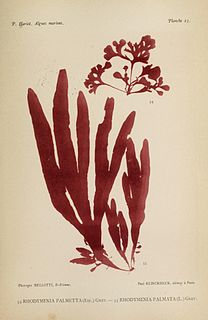
Rhodymenia is a genus of red algae, containing the following species:

Laurencia is a genus of red algae that grow in temperate and tropical shore areas, in littoral to sublittoral habitats, at depths up to 65 m (213 ft).
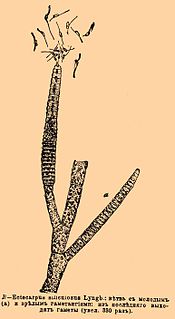
Ectocarpus is a genus of filamentous brown alga that is a model organism for the genomics of multicellularity. Among possible model organisms in the brown algae, Ectocarpus was selected for the relatively small size of its mature thallus and the speed with which it completes its life cycle. The type species for the genus is Ectocarpus siliculosus (Dillwyn) Lyngbye. The life history is an isomorphic to slightly heteromorphic alternation of generations, but asexual strains also exist.

Anna Antoinette Weber-van Bosse was a Dutch phycologist, specializing in marine algae.

Rivularia is a genus of cyanobacteria of the family Rivulariaceae.

Dictyota is a genus of seaweed in the family Dictyotaceae. Species are predominantly found in tropical and subtropical seas, and are known to contain numerous chemicals (diterpenes) which have potential medicinal value. As at the end of 2017, some 237 different diterpenes had been identified from across the genus.
Sporolithon is a genus of red coralline algae in the family Sporolithaceae, in the order Corallinales.
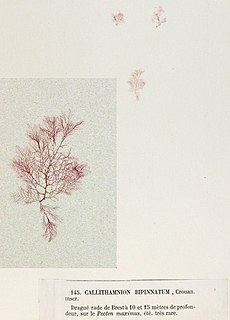
Aglaothamnion is a genus of algae belonging to the family Callithamniaceae.















